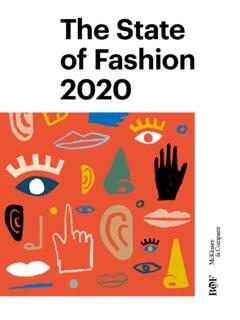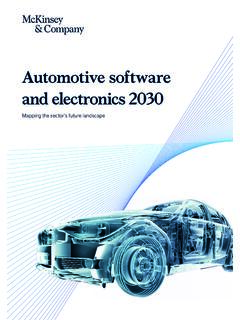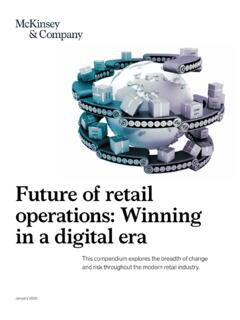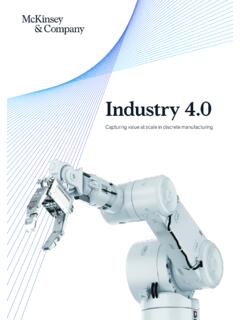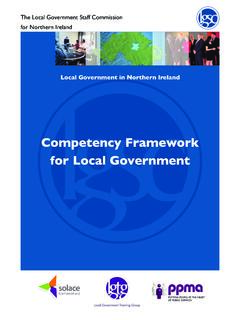Transcription of Is apparel manufacturing coming home? - McKinsey & …
1 Is apparel manufacturing coming home? Authored by:Johanna AnderssonAchim BergSaskia HedrichPatricio IbanezJonatan JanmarkKarl-Hendrik MagnusMcKinsey apparel , Fashion & Luxury Group October 2018 Nearshoring, automation, and sustainability establishing a demand-focused apparel value chain2Is apparel manufacturing coming home? 3 Table of ContentsIntroduction 4Is apparel manufacturing coming home? 6 Era of change 6 Nearshoring breakeven 10 Overcoming challenges in nearshoring 12 The prospect of automation 15 Promising automation technologies
2 15 Economic viability of automation 18 How quickly can the prospect become reality? 21 The automation journey 23 Embarking on the journey 24 Defining the future sourcing and production strategy 24 Developing new skills and changing mindsets 26 Building a new ecosystem of partnerships 27 Taking the first step 28 Table of Contents4Is apparel manufacturing coming home?
3 Tomorrow s successful apparel companies will be those that take the lead to enhance the apparel value chain on two fronts: nearshoring and automation. It cannot be just one of them and it must be done sustainably. apparel companies can no longer conduct business as usual and expect to thrive. Due to the Internet and stagnation in key markets, competition is fiercer than ever and consumer demand is more difficult to predict. Mass-market apparel brands and retailers are competing with pure-play online start-ups, the most successful of which can replicate trendy styles and get them to customers within weeks. Furthermore, apparel companies have lost much of their clout in trendsetting.
4 In most mass-market categories, today s hottest trends are determined by individual influencers and consumers rather than by the marketing departments of fashion companies. Pressure on profitability due to decreasing full-price sell-through as well as increasing concerns regarding the environmental impact of overproduction call for agile production in smaller batch sizes and for on-demand light of these factors, speed to market and in-season reactivity are now more critical than ever to apparel players success. Indeed, nearly two-thirds of US apparel executives1 and about 80 percent of international chief procurement officers (CPOs) say that these two capabilities are top The problem is, most of the established fashion players are burdened with slow commercial processes and legacy supply chain and sourcing setups and therefore struggle to keep up with more nimble competitors.
5 Mass-market apparel brands and retailers cannot win in the next decade without speeding up and transforming to a demand-focused model. apparel companies are applying four key levers to support the transformation. One is optimization of current processes, , central cross-functional merchandising teams, reduction of approval iterations, and closer collaboration with Another is digitization of processes along all phases of the fashion cycle from intelligent consumer insights to virtual design and prototyping to integrated vendor- management tools and digital sell-in. They will rethink inbound logistics , aiming to strike an effective balance of air versus sea freight and establish highly efficient warehouse processes.
6 And the other is optimizing the apparel production model, on which we will focus in this white paper, including elements such as nearshoring, automating new delivery models around customization, and shifts toward sustainable, circular value chains. Two decades ago, US and European mass-market apparel brands and retailers were rushing to move as much production to Asia as possible in order to gain a cost advantage. Since then, it has been a unit-cost play, in which adjusting the sourcing footprint and moving from China to even more cost-efficient frontier markets has been the focus. apparel players that have successfully done this, while still ensuring high quality, speed, and compliance, have been able to deliver relevant products to consumers at the best prices.
7 So, the question is: is apparel manufacturing coming home? 1 Survey of 100 US apparel executives by McKinsey and Women s Wear Daily. The need for speed: Capturing today s fashion consumer, McKinsey & Company, Inc., March 2018, Based on the 2017 McKinsey apparel Chief Procurement Officer (CPO) Survey. Digitization: The next stop for the apparel -sourcing caravan, McKinsey & Company, Inc., September 2017, Measuring the fashion world: Taking stock of product design development, and delivery. New white paper on product development and end-to-end process optimization to be published October 25, 2018 Introduction5 IntroductionToday, the industry is at a crossroads, where speed beats marginal cost advantage and basic compliance is upgraded to an integrated sustainability strategy .
8 While the traditional supply chain setup is now being challenged and as labor costs converge, mass-market brands and retailers are starting to more broadly rethink their sourcing and production models. Moves to increase nearshoring and more automated production models have the potential to further enable sustainability and to support the adaptation of a circular economy in the apparel sector. Mass-market apparel players that embrace automation technologies to become faster and more sustainable will likely be tomorrow s winners. For many apparel companies, this may seem like a daunting task. Their lead times are long; their production processes laborious and linear.
9 So, what can they do? The answer is to make bold, yet disciplined and balanced investments in nearshoring, automation, and sustainability and to do it immediately. The aim of this white paper is to help mass-market apparel brands and retailers embark on this journey. It clarifies the future demand-led apparel sourcing and production models, their current economic viability, and the future outlook. To develop this white paper, we collaborated with the leading textile technology and textile manufacturing research institute, the Institut f r Textiltechnik of the RWTH Aachen University, as well as our Digital Capability Center Aachen (DCC Aachen) on analyzing current and potential automation technologies.
10 We also worked with the economic think tank McKinsey Global Institute (MGI) to better understand the future of factor costs. Additionally, we conducted interviews with a broad range of international experts and practitioners in apparel manufacturing and retailing as well as robotics and sustainability. We also asked apparel sourcing executives and industry participants to comment on the industry disruptions of nearshoring, automation, and sustainability in a survey conducted in September Our white paper also provides guidance on where to start the journey based on transformation work we have conducted with international apparel manufacturers, brands, and McKinsey and Sourcing Journal Survey, September 4-13, 2018.

